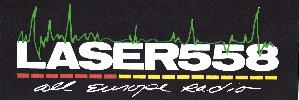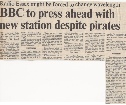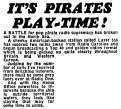© 2014-


Laser 558 - History (3)
These few days of tests had been broadcast to prove to Philip Smyth as well as potential advertisers that the station could transmit a reasonable signal and that the music format would be popular with listeners. As proof of this over 2,000 letters and reception reports were received at MMI's New York office following the five days of test broadcasts. After the success of the test broadcasts Philip Smyth, agreed to fund the construction of a permanent aerial system on board the Communicator which would enable Laser to return to the air permanently.
American engineer David Irvine, who had previously worked for the US Navy and US Coastguard, was contracted to design and build the new aerial system, which he decided to do on land despite advice about contravening the British Marine etc. Broadcasting (Offences) Act. A telescopic mast structure was acquired and partially assembled at a boat yard in Queensborough, Essex ready for transportation to the Communicator. However, police and Department of Trade officials had become aware of what was going on and mounted a raid on the yard on 16th March 1984, arresting several men working on the mast construction.
The raid and subsequent confiscation of the telescopic aerial was a major set back to Laser, further delaying its planned official launch. Following the raid the landbased side of the operation placed a number of orders with different suppliers for the necessary replacement aerial system -
Eventually, a set of mast sections were delivered to the Communicator by the third week in April and erected on board the ship during the Easter weekend of 1984. Once both the masts had been constructed the aerial system was wired up and after about two weeks continuous work the station was now ready to re-
Further test broadcasts continued for various periods throughout May 1984 and then, without any prior announcement, official programming for the new offshore radio station -
The new station quickly  started advertising its own promotional items, including T-
started advertising its own promotional items, including T-
Laser 558's non-
Throughout the summer of 1984 Laser 558 continued to grow in popularity. Audience figures of 5 million listeners were claimed for the station, whose music policy was summarised by the slogan "You're never more than a minute away from music." Certainly in Britain it was acknowledged that the station had taken vast numbers of listeners from Capital Radio in London, other local ILR stations particularly in Kent and Essex and, most significantly, from BBC Radio One.
Complaints were received during the summer of 1984 about interference to broadcasts from Radio Telefis Eireann (RTE) from Laser 558's transmitter. However, the interference was not being experienced by listeners in the Irish Republic (RTE's target audience) but by those living in England, mainly London, who wished to tune in to the Irish station's transmissions, well outside its authorised reception area. RTE's London Representative, John O'Callaghan, complained to Laser 558's lawyer, Glenn Kolk, and to the sales representative from MMI, Roy Lindau, about interference from the offshore station. The Irish broadcaster received little sympathy from the Laser 558 men -
Another potential frequency conflict loomed with the announcement at the end of August 1984 that the new BBC local station, Radio Essex based in Chelmsford (planned to open in 1985) had been allocated the 558kHz frequency.

Opening of Laser 558, Ric Harris, May 1984


Click on picture to enlarge

East Anglian Daily Times
24th May 1984

East Anglian Daily Times
24th August 1984
Keyring offer



Car radio tuning promo

‘Owned and operated by Eurad SA’ announcement


History
Key Dates
Ship and Location
Technical
Staff
Programmes






The Sun
31st May 1984




Back to Britain Gallery


Back to Laser 558
